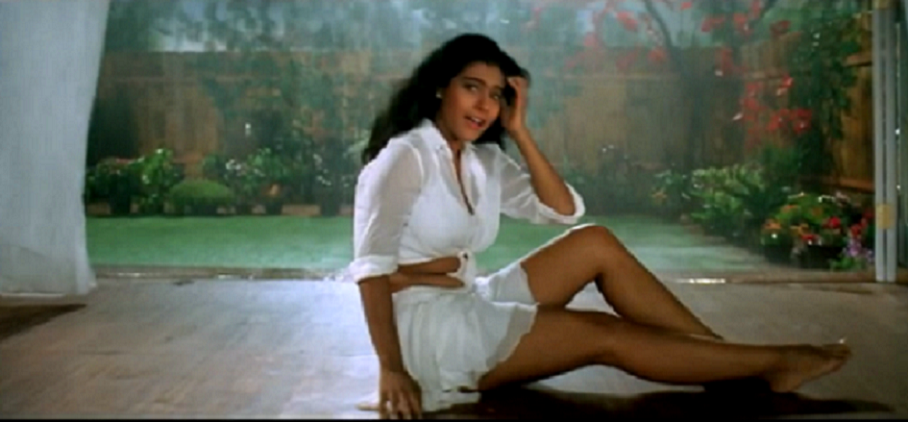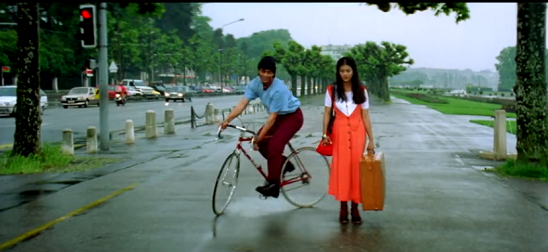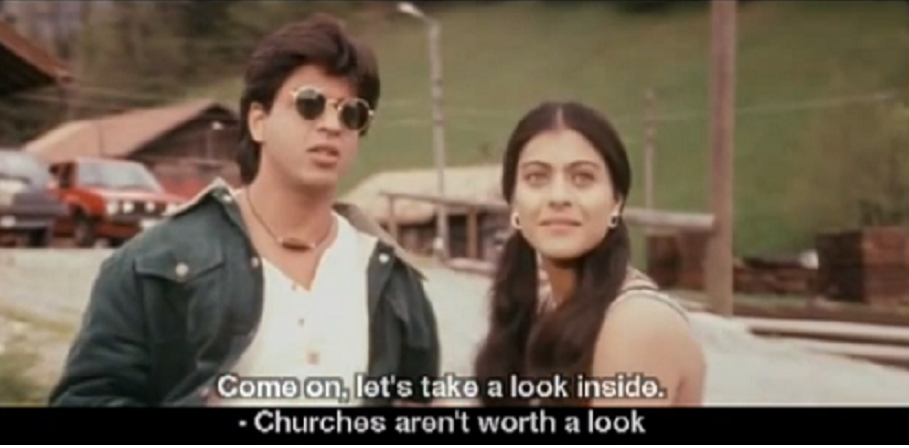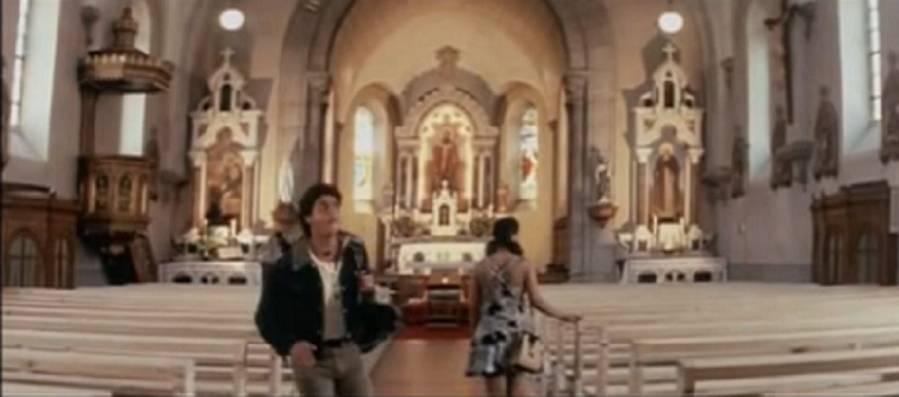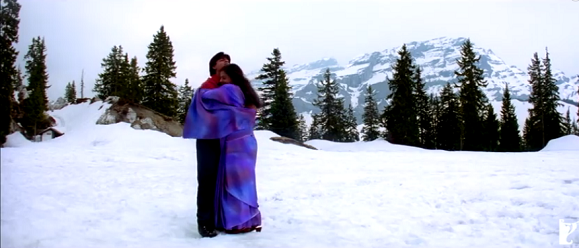Dilwale Dulhania Le Jayenge

This is a collection of articles archived for the excellence of their content. |
Contents |
Sources
Dilwale Dulhaniya Le Jayenge : Lesser Known facts The Times of India <> Dilwale Dulhania Le Jayenge's record breaking run at Maratha Mandir comes to an end today V Lakshmi,TNN | Feb 19, 2015 The Times of India <> Mitwa: Obama’s DDLJ moment Srijana Mitra Das,TNN | Jan 28, 2015 The Times of India
The film
The film told a very simple love story of Raj and Simran, played on the silver screen by Shah Rukh Khan and Kajol respectively
Shah Rukh Khan played the charming loverboy Raj Malhotra in Dilwale Dulhania Le Jayenge. Apparently Shah Rukh was not the first choice for the film. Dilwale Dulhania Le Jayenge defined a huge milestone in SRK's career, but it was not actually meant to happen.
Shah Rukh Khan's portrayal of Raj Malhotra's loving ways and humorous mannerisms made him an instant favourite. However there is a reason why SRK's character was named Raj.Apparently Aditya Chopra had named Shah Rukh Khan's character Raj after the famous actor Raj Kapoor, while the title for this movie was suggested by Kirron Kher, wife of Anupam Kher, who plays SRK's father in the film.
The film's title was a phrase in the song "Le jayenge le jayenge, Dilwale Dulhania Le Jayenge" from the film Chor Machaye Shor (1974).
Dilwale Dulhania Le Jayenge had many firsts. The film marked the debut of television actress Mandira Bedi. She played the character of Parmeet Sethi's sister. In the film Mandira falls for Shah Rukh Khan, who is actually in love with Kajol. Dilwale Dulhania Le Jayenge also marked the onscreen debut of filmmaker, Karan Johar. His brief stint was to play SRK's friend in the movie.
The making of the film
The character of Raj was first offered to Saif Ali Khan who turned down the role after which Shah Rukh Khan came into the picture.
The music of Dilwale Dulhania Le Jayenge was a huge hit. A lot of hard work went in creating those foot tapping numbers. 'Mere Khwaboon Mein Jo Aaye' was the first song to be recorded. And according to IMDB, Aditya Chopra rejected 24 verses by Anand Bakshi before giving a nod to the final one.
While another hit number, 'Mehndi Laga Ke Rakhna' that featured Shah Rukh Khan and Kajol was actually made for some other movie. But as destiny had it, the song went on to be one of the biggest hits of DDLJ.
The huge success of Dilwale Dulhania Le Jayenge also established Aditya Chopra as an ace director. To get the best out of his team of actors, Aditya tried out a few tricks too. In the end of the song, 'Rukh Jaa O Dil Deewane,' Shah Rukh Khan drops Kajol. However, Aditya Chopra had not informed Kajol about the same, so as to capture her genuine and candid reaction. Also Aditya Chopra had some trouble filming the sequence where Raj jokes with Simran about the previous night. The reason was that every time Shah Rukh Khan would open his shirt, Kajol would start laughing. The pictures of the lips on Shah Rukh's chest were drawn by Kajol.
Denying Honey Irani credit
The film was mired in a major controversy after its release. Honey Irani and Javed Siddiqui said that they had not been given credit for screenplay and dialogues respectively.
On the official website of YashRajFilms, director Aditya Chopra got someone to ask him about the allegation.
Q: What do you have to say about the controversy over the script of Dilwale Dulhania Le Jayenge... following Honey Irani's statements that she was denied credit?
Aditya Chopra’s reply: “I can answer that question only by saying that ever since I can remember the only thing I ever wanted out of life was to make films... the dream was to make films which were commercially successful and critically acclaimed. But the most important part of the dream was the sense of belonging, the feeling of being part of a group of wonderfully talented people.
“Today after the success and appreciation of my film, I should feel that the dream has come true. But I don't. Because there is a doubt about my honesty, integrity and capabilities. As I told you, I've always believed that one's work should speak for oneself. So, I think I'll have to start all over again from the beginning - try and work harder, try and write a better script, make a better film and hope that it will meet with this kind of success and appreciation again. Hopefully then, there won't be any doubts left. Hopefully then, I'll feel that I belong here. Believe me, that's my honest response to your question... and that's all I will ever say on the subject.”
If DDLJ was a romantic masterpiece, Mr Chopra’s 187-word is a masterpiece of ducking the question—beautifully, even lyrically.India's best-known example of gobbledygook.
Unless Mr Chopra is being gentlemanly--and feels that Mrs Irani did not deserve credit.
However, noted actor-director Farhan Akhtar told Aseem Chhabra The Rediff Movie Special that his mother Honey Irani had written the script for director Aditya Chopra's Dilwale Dulhania Le Jayenge, but was not given credit for her work. The story goes that this affected Akhtar's friendship with Chopra and more so with the director's younger brother Uday. And Akhtar eventually incorporated that break in his friendship with Uday into the plot of Dil Chahta Hai.
"I would be lying if I said I wasn't upset," Farhan Akhtar says. "Not just at Uday, but at all of them. Because these are people I knew for practically all my life. It really upset my Mom for a long time because they were her close friends. But no, it was not an inspiration for Dil Chahta Hai."
Time has healed things, Akhtar says, and he maintains a cordial relationship with the Chopra brothers. "Unfortunately, there are certain things you cannot forget," he adds.
Offending the Christians
(There are pictures from the church sequence on this page.)
‘DDLJ’ had a needless sequence in which Simran wants to go to a church in Interlaken and Raj makes a face and casually keeps munching on a chocolate bar when he hears her plans.
Simran: Wow! What a beautiful church. Chalo andar say dekhtey hain
Raj: Arrey andar say kya dekhtey hain? Church bhi koi dekhney ki cheez hai? Mujhe nahin jana (See picture)
Raj (with unconcealed sarcasm): Yes, it’s really beautiful. Jao tum andar say ja kay dekh lo.
The reluctant Raj is pulled into the church and, upon entering, monkeys about. He makes funny sounds (Hoe-ooow, hurrrrrr, etc), jumps about noisily and spins around noisily. He is basically trying to say, I am too cool to be in a church.
Then ‘Raj mak[es] the usual sign of one wanting to go and relieve himself [urinate],’ writes Planet SRK. (See picture)
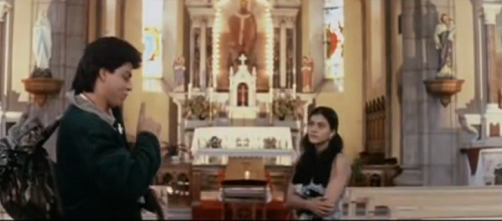
However, in fairness, maybe this gesticulation was inadvertent.
Shahrukh Khan and Kajol in Dilwale Dulhania Le Jayenge (1995)
He whistles and hisses as he dances his way towards the Bible.
Then he finds Simran’s piety at the altar amusing. He casually fidgets with a bell near the Bible and ruffles through the Bible while she is praying and makes more faces to indicate this.
Finally, in an act of magnanimity towards Lord Jesus, Raj goes to the altar, kneels and addresses the Jesus idol (offscreen) with an irreverent ‘Hi!,’ introduces himself, like a cool-dude, as Raj and clarifies that he is not there for himself.
Considering how parochial YRFilms have been over the decades, concentrating (as in DDLJ) on Malhotra heroes, who belong to the Chopras’ own clan, to the exclusion of the Indian minorities in particular, this scene offended the Christians (as it was obviously meant to), who protested gently and with dignity through press statements.
President Obama, DDLJ and Mitwa
It was possibly the most filmi speech by a US President. Addressing media, students and civil society groups at Delhi's Siri Fort Auditorium in January 2015, Barack Obama started with Shah Rukh and ended with Aamir Khan.
In a talk containing as many cultural references as bilateral plans, President Obama had his audience cheer when he described the "pretty good bhangra" wife Michelle and he displayed on their last stay, pouting he felt "a little hurt" when newspapers described Michelle as a better dancer.
Obama stopped several hearts when he smiled at Michelle and murmured, "Senorita, bade bade deshon mein...", the vintage DDLJ line.
But even as the audience burst into applause, Obama mentioned Shah Rukh Khan again, alongside Milkha Singh and Mary Kom as Indian achievers.
As his speech closed, Aamir Khan's 'Mitwa' from Lagaan burst forth on the hall's speakers, its 'Tu aaja re' lyrics evidently encouraging the students mobbing the Obamas. The enthusiastic response and 'O-ba-ma!' chants could be understood, given the President's blockbuster speech.
The record breaking run
Dilwale Dulhania Le Jayenge released on October 19, 1995, just a couple of weeks before SRK's 30th birthday. The film was a huge hit with the audiences
After the 1000 week celebrations in December 2014, the theatre had requested Yash Raj Films to prepone the DDLJ morning show to 9:15 AM instead of 11:30 AM as it was becoming difficult for the cinema to accommodate multiple new releases every week with just 3 regular shows.
YRF obliged from 13th Feb 2015. However, while the theatre management was happy to continue the film for as long as it continued to draw in the audiences, owing to logistical issues of their staff having to work inordinately long hours to accommodate an additional early morning show, it was mutually decided to end the films historic & record breaking run.
After a historic, uninterrupted 1009-week run, Dilwale Dulhania Le Jayenge made its 'final' curtain call at the iconic Maratha Mandir in the 9:15 AM show on 19 Feb 2015.
[ Indpaedia says 'Never say never again,' because after a break the film was back at Maratha Mandir]
In 2023, The New York Times revisited India’s longest-running film
‘D.D.L.J.,’ which a Mumbai theater has shown nearly every day since 1995, encapsulates a society in churn, with the choices afforded by economic opportunity clashing with tradition.
A woman who goes by the name Simran has become a regular at screenings of “Dilwale Dulhania Le Jayenge” at the Maratha Mandir cinema in Mumbai.Credit...
Mujib Mashal and Suhasini Raj spent time at the Maratha Mandir cinema over two trips to Mumbai reporting this story.
Well past the film’s intermission, the crowd keeps trickling in. Some pay at the ticketing window with a couple of taps on their phone; others dump fistfuls of coins. They are students and office clerks, prostitutes from the waning red-light district nearby, day laborers still chasing dreams in India’s “maximum city,” and the homeless with dreams long deferred.
India’s film industry puts about 1,500 stories on the screen annually. But the audience that files every morning into the Maratha Mandir cinema in Mumbai is here for a movie that premiered 27 years ago — and has resonated so intensely that this once-grand 1,100-seat theater has played it every day since, save for a pandemic hiatus.
The film, “Dilwale Dulhania Le Jayenge” — which translates as “The Big-Hearted Will Take the Bride” and is known as “D.D.L.J.” — is a boy-meets-girl story set against the backdrop of a moment of immense change and unbridled possibility in India.
The Indian economy had just opened up, bringing new opportunities, new technologies and new exposure to a rising middle class. But it also brought new strains, as the choices afforded by economic opportunity — to decide your own love and your own life — ran up against the protective traditions of old.
In many ways, the India of today looks like the India reflected in the movie. The economy is still on the rise, and it is now about 10 times the size it was in the mid-1990s. A technological revolution, this one digital, has opened new worlds. Women are seeking more freedom in a male-dominated society. And the forces of modernity and conservatism remain in tension as an ascendant political right wing appoints itself the enforcer of conventional values.
The sense of unlimited possibility, however, has receded. As the early rewards of liberalization peaked and economic inequities deepened, aspirations of mobility have diminished. For those left behind, the world of “D.D.L.J.” — its story and stars, its music and dialogue — is an escape. For those still striving, it is an inspiration. And for those who have made it, it is a time capsule, the starting point of India’s transformation.
“Dilwale Dulhania Le Jayenge,” which translates as “The Big-Hearted Will Take the Bride.”
“It grew and grew and grew and went on to, you know, become an heirloom,” said the actress Kajol, 48, who played the female lead, Simran, in the film. “I have had so many people who told me that, you know, we have made our children sit down and watch ‘D.D.L.J.,’ we have made our grandchildren sit down and watch — and I was like, there are grandchildren now?”
She burst out laughing. “Children I am fine with. But grandchildren?”
When the pandemic closed theaters for a year, many speculated that “D.D.L.J.’s” record run would end. But the film is back on for its 11:30 a.m. slot at Maratha Mandir, often drawing crowds larger than those at afternoon screenings of the latest releases.
Some of those who show up have watched it here so many times that they have lost count — 50, 100, hundreds.
A taxi driver who was in the line outside the theater one morning this fall had seen it six times, a welder about a dozen. A gray-bearded merchant of secondhand goods claimed about 50 viewings, the same for a 33-year-old delivery worker.
Then there were the regular regulars, those who trek here nearly every day. Madhu Sudan Varma, a 68-year-old homeless man who has a part-time job feeding neighborhood cats, comes about 20 mornings a month.
The woman with her head wrapped in a plastic bag?
“I come every day,” she said. “I like it every day.”
No one knows her real name — it may be Jaspim, but even she is unsure. It doesn’t matter, because everyone calls her by the name she prefers: Simran, just like the star on the screen.
Lying at night in the room she keeps as a prostitute in Kamathipura, Mumbai’s red-light district, she sometimes dreams of the film’s scenes, she says. In the morning, she makes sure she doesn’t miss the show — not even on this day when the henna she used to dye her graying hair hadn’t yet dried. She would rather come wearing a plastic bag than not make it.
‘Live Your Life’
“D.D.L.J.” is a love story. But it is also about compromise.
Kajol’s character, Simran Singh, is brought up in London, though her father uses the income from the family’s corner store to raise his children in the traditions of India.
On a European trip with friends, Simran meets Raj Malhotra, played by Shah Rukh Khan, a wealthy young man raised by a single father. The rest of the film’s three hours are spent on the couple’s efforts to persuade Simran’s conservative father to let go of the arranged marriage he had planned for his daughter and bless their union.
“Go, Simran, go,” the father declares at the end, after the film barrels through tears, bloody fistfights and many songs of longing. “Live your life.”
Kajol said that the movie’s middle path had broken new ground. Before “D.D.L.J.,” she said, “we only had films that talked about either this way or that — either we had films that celebrated marriages and everybody was involved from uncles to aunties, or it was ‘us against the world, we will fight it out, we will live together, die together.’ I think ‘D.D.L.J.’ came up with a very simple thought — to say that maybe we can walk a line.”
When the movie was released in 1995, Kajol and Mr. Khan were both relative newcomers. Kajol went on to become one of the most successful actresses in Hindi cinema. Mr. Khan, 57, found even greater fame, becoming one of India’s most recognizable faces.
Both actors benefited from an Indian entertainment industry that was itself in transition, as money flooded in with the country’s economic liberalization.
Now, the country has over 200 million households with televisions, up from 50 million then. Many more people can afford cinema tickets. And India, which recently became the world’s fifth-largest economy, is expected to have one billion smartphone users by 2026.
Film stars have become permanent fixtures on billboards and on television commercials. India is a huge market — it is projected to soon pass China as the world’s most populous country — and a star’s simple post of sponsored content on platforms like Instagram can be lucrative. Actors who would once perform in different films in the same change of clothes now find themselves with unfathomable wealth.
Every day, fans throng outside Mr. Khan’s seaside home in Mumbai, the heart of India’s film industry, hoping for a sighting. Buses passing the road in front of his house slow down so passengers can take selfies.
A crowd gathered outside Mr. Khan’s house in Mumbai to get a glimpse of the popular actor on his birthday. He has challenged perceptions of masculinity in Indian filmmaking.
On his birthday, thousands gather, waiting and chanting for Mr. Khan — and he does not disappoint. He climbs up a caged platform, throwing kisses at the fans, before breaking into what has become his signature move: a leaned-back spread of the arms.
Bollywood has long favored those with legacy and family ties. Mr. Khan resonates as an outsider, a child of middle-class struggle in Delhi who lost both of his parents when he was young.
The towering residence he now occupies with his family “is a middle-class monument to a man who didn’t own property,” said the Indian economist Shrayana Bhattacharya. “He became this prism and this concept. He represents this idea of mobility.”
Ms. Bhattacharya wrote a book, “Desperately Seeking Shah Rukh,” about how Mr. Khan symbolizes the possibilities that only India’s liberalized economy could produce, and what he has meant to young working women as he has challenged perceptions of masculinity in Indian cinema.
Taking advantage of new channels of information, he has built an image of an empathetic partner who listens, helps with household chores and shares the spotlight with female co-stars.
The power of this image, he said in one interview, has become such that he has become “an employee of the myth of Shah Rukh Khan.” It is so potent that young women, Ms. Bhattacharya said, “want to be him” rather than want to “marry him,” the emotion usually associated with older matinee idols.
To some women, Mr. Khan — or at least his persona — is a reminder of the ways Indian men have not changed. Surbhi Bhatia, a data and development researcher in Mumbai, said she often binge-watched his talks as an antidote to the restrictive male energy around her. If she is feeling low or uncertain, she strolls down to linger outside his seaside residence.
“You know when he spreads those arms,” she said about Mr. Khan’s signature move, “there is space to just go in.”
In many ways, women have yet to achieve the economic promise of the new India. Only about a quarter of women participate in the work force, less than half the rate of all other major economies.
For women who have found economic opportunity, society has been slow to accept their independence. Having their own incomes — or even just a smartphone — has translated into some new freedom. But when a husband comes into the picture, Ms. Bhatia said, it brings another layer of permission and the forfeiture of leisure hours to household chores.
“The phone has done so much to give access, but not solved the larger problem,” she said. “It’s making us more lonely.”
India is still trying to decide where to set the line that “D.D.L.J.” suggested it walk between conservatism and modernity. Added to the tension is a Hindu-first fervor under Prime Minister Narendra Modi, with Muslims in particular becoming a target. Mr. Khan, despite his crosscutting appeal, has not been spared.
This month, right-wing groups vandalized cinemas promoting Mr. Khan’s latest film after a trailer showed its female star, Deepika Padukone, wearing a saffron bikini. The groups called the choice of saffron an offense to Hinduism, which is closely associated with the color.
Mr. Khan is a product of a secular India — a Muslim who attended a Christian school and married a Hindu. Faced with attacks like these, he has largely stopped commenting on the country’s political direction.
“I am a Muslim, my wife is a Hindu and my kids are Hindustan,” Mr. Khan said on a television show in 2020, using another word for India. “When they went to school, they had to write their religion. My daughter came to me once and asked, ‘What is our religion?’ I simply wrote in her form that we are Indian.”
‘Love Doesn’t End’
At the Maratha Mandir cinema, the logic of keeping one film running for nearly three decades is simple economics: New films could be hit or miss, but the crowd for “D.D.L.J.” is steady.
“This picture is evergreen,” said Manoj Desai, the cinema’s 72-year-old executive director, “because it tells the story of true love. Because love doesn’t end.”
The theater’s position near two transportation hubs ensures constant traffic. And it helps that the tickets are cheap: 30 rupees for downstairs seats and 40 for those in the balcony, or about 40 to 50 cents, a quarter of the price for admission to new releases.
Manoj Desai, the executive director of the Maratha Mandir cinema. “This picture is evergreen,” he said of the movie, “because it tells the story of true love.”
“Three hours in air-conditioning, 40 rupees. Who will refuse that?” Mr. Desai said.
The interview with Mr. Desai was interrupted by frequent phone calls, including one from his wife. “Home minister,” he said as he picked up her call.
He and his wife, who are celebrating their 50th wedding anniversary, went through a caste-based love struggle of their own, though with a different ending from the one in “D.D.L.J.”
When her wealthy Jain parents refused Mr. Desai, a Gujarati Brahmin, they eloped and made their marriage official in a faraway temple. Her family kept looking for them for two years, trying to register her as a minor to charge Mr. Desai with kidnapping.
“Love has changed in the sense that breakups are easy,” Mr. Desai lamented.
As he spoke, reporters called to inquire about a recent storm Mr. Desai had kicked up. In a scathing video interview, he had called a rising star “arrogant” for talking about taking his films directly to streaming services. The star was sent by his father on a private jet to Mr. Desai’s office to touch his feet and apologize.
With Hindi cinema struggling to regain momentum after its pandemic lull, many producers and stars have opted to take their films directly to streaming platforms such as Netflix and Amazon.
To purists like Mr. Desai, the growing trend is blasphemy. “There is the money, but sirrrrr,” he said, stretching and rolling his “r.” “What about theater? What about the big screen?”
For the entire time that “D.D.L.J.” has been showing on Mr. Desai’s big screen, Jagjivan Maru has been the projectionist. He will soon retire after 50 years.
The film draws a seemingly unending stream of viewers with themes that resonate across generations.When he sets up the day’s show, staff downstairs change into their uniforms, prepare the popcorn and samosas in the dimly lit corner concession stand and mop the marble floor between the rows of worn-out seats.
“For 10 years, the hall would be full — there would queues for tickets,” he said about the film’s release in 1995. “After 10 years, it cooled off a bit — but the passion hasn’t died.”
As customers line up to enter the theater, the guards frisking them and checking their bags repeat one reminder: “Don’t put your feet on the seats.” They know it’s futile, because many come precisely for that — to escape the city’s heat, to put up their feet.
Mr. Varma, the 68-year-old homeless man, arrives at the ticket counter with his two bags of belongings, containing a blanket, some changes of clothes and his water bottle.
He sleeps in a parked auto rickshaw near a Buddha statue. Waking before dawn, he feeds about 50 neighborhood cats, for which an NGO pays him 100 rupees — roughly $1.30 — a day.
He worked in the family’s furniture upholstery business before a dispute forced him to the streets. He has lost everyone dear in his life, from his siblings to his parents.
But one person resurfaced about 15 years ago: an unrequited love that had left him a bachelor. Caste differences made their union impossible, just as they prevent many love stories even today. The woman got married in 1984 and went on to have children who are now married.
The rekindling is one of friendship. They speak by phone once a month; he asks about her life, her children, and she asks if he is eating well.
“There were others who would call in the past,” Mr. Varma said. “There is no one else now.”
Mr. Varma takes his seat on the ground floor of the cinema hall. In the row in front of him is Simran, the prostitute.
Simran, so named after the movie’s lead female character, dancing to one of the movie’s many songs.
When the movie’s wildly popular songs come on, Simran shimmies in her seat, singing along and getting up to dance in the aisle. She mimics the dialogue. And when the Simran on the screen waves goodbye to Raj, the Simran in the theater also waves her hand in goodbye.
Every time the light from the screen reflects on Mr. Varma’s face, he is lounged in his seat, his soft eyes glued to the film.
“I find peace here,” Mr. Varma said. “I get a little calm.”
© 2023 The New York Times Company
Cast
Shah Rukh Khan/ Raj Malhotra
Kajol/ Simran Singh
Parmeet Sethi/ Kuljeet
Amrish Puri/ Chaudhry Baldev Singh
Farida Jalal/ Lajwanti Singh (Lajjo)
Anupam Kher/ Dharamvir Malhotra
Satish Shah
Achala Sachdev
Himani Shivpuri
Anaita Shroff
Karan Johar
Mandira Bedi
Preeti Singh
Uday Chopra (cameo)
Crew
Director
Aditya Chopra
Writers
Aditya Chopra ... (screenplay)
Javed Siddiqui ... (dialogue)
Producer
Yash Chopra ...
Cinematography
Manmohan Singh
Editing
Keshav Naidu
Art Direction
Sharmishta Roy
Songs
Music
Jatin Lalit
Lyrics
Anand Bakshi
Playback singers
Abhijeet
Ajay Trivedi ...
Asha Bhosle ...
Kumar Sanu ...
Lata Mangeshkar ...
Manpreet Kaur ...
Pamela Chopra ...
Udit Narayan ...
Choreography
Farah Khan
Saroj Khan
Awards
Filmfare Award for Best Film
1996 · Yash Chopra
Filmfare Award for Best Director
1996 · Aditya Chopra
Filmfare Award for Best Actor
1996 · Shah Rukh Khan
Filmfare Award for Best Actress
1996 · Kajol
Filmfare Award for Best Dialogue
1996 · Aditya Chopra, Javed Siddiqui
Filmfare Award for Best Performance in a Comic Role
1996 · Anupam Kher
Filmfare Award for Best Screenplay
1996 · Aditya Chopra
Filmfare Award for Best Supporting Actress
1996 · Farida Jalal
The award not given
The film's songs broke sales records. HMV's executive director Harish Dayani estimates that one in three households in India owns the DDLJ soundtrack. All of India? Maybe not. But 'one third of households in the Hindi-Urdu belt who own a music player' would be more accurate
"Tujhe dekha to yeh jaana sanam", "Mehandi lagaake rakhna", "Mere khwabon mein jo aaye", "Ho gaya hai tujhko to pyar sajana", "Zaraa sa jhoom loon main" and "Ghar aaja pardesi" were extremely popular. See Hindi-Urdu hit songs: 1996 list
Jatin Lalit, who composed seven melodious and superhit tunes for the film missed out on the music awards though Udit Narayan and Anand Bakshi won many trophies, as did the rest of the film’s crew and cast.
The market rewarded Jatin Lalit, and they became major composers for Hindi-Urdu films.
See also
Indian cinema: 1990-99 <> Hindi-Urdu cinema: 1990-99 <> Hindi-Urdu hit songs: 1996 list <> Yash Chopra <> Yash Raj Films <>Dilwale Dulhania Le Jayenge <> Sultan (2016)
